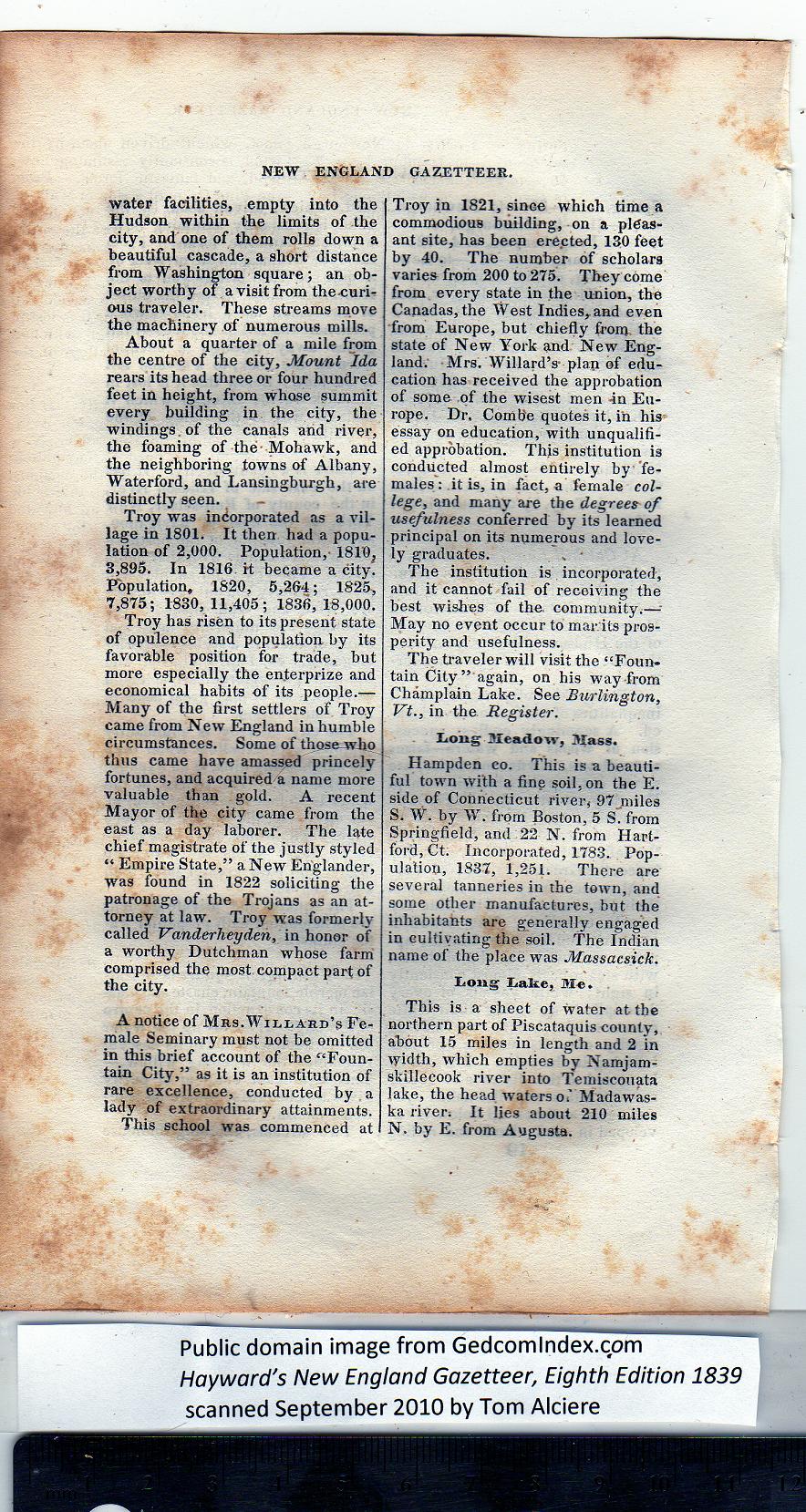|
water facilities, empty into the
Hudson within the limits of the
city, and one of them rolls down a
beautiful cascade, a short distance
from Washington square; an ob-
ject worthy of a visit from the-curi-
ous traveler. These streams move
the machinery of numerous mills.
About a quarter of a mile from
the centre of the city, Mount Ida
rears its head three or four hundred
feet in height, from whose summit
every building in the city, the
windings, of the canals and river,
the foaming of the Mohawk, and
the neighboring towns of Albany,
Waterford, and Lansingburgh, are
distinctly seen.
Troy was incorporated as a vil-
lage in 1801. It then had a popu-
lation of 2,000. Population, 1810^
3,895. In 1816. it became a city.
Population, 1820, 5,264; 1825,
7,875; 1830,11,405; 1836, 18,000.
Troy has risen to its present state
of opulence and population hy its
favorable position for trade, but
more especially the en.terprize and
economical habits of its people.—
Many of the first settlers of Troy
came from New England in humble
circumstances. Some of those who
thus came have amassed princely
fortunes, and acquired a name more
valuable than gold. A recent
Mayor of the city came from the
east as a day laborer. The late
chief magistrate of the justly styled
“ Empire State,” a New Englander,
was found in 1822 soliciting the
patronage of the Trojans as an at-
torney at law. Troy was formerly
called Vanderheyden, in honor of
a worthy Dutchman whose farm
comprised the most compact part of
the city.
A notice of Mes.Willard’s Fe-
male Seminary must not be omitted
in this brief account of the “Foun-
tain City,” as it is an institution of
rare excellence, conducted by a
lady of extraordinary attainments.
This school was commenced at |
Troy in 1821, since which time a
commodious building, on a pleas-
ant site, has been erected, 130 feet
by 40. The number of scholars
varies from 200 to 275. They come
from every state in the union, the
Canadas, the West Indies, and even
from Europe, but chiefly from the
state of New York and New Eng-
land. Mrs. Willard’s- plan of edu-
cation has received the approbation
of some of the wisest men In Eu-
rope. Dr, Combe quotes it, in his
essay on education, with unqualifi-
ed approbation. This institution is
conducted almost entirely by fe-
males: it is, in fact, a female col-
lege, and many are the degrees of
usefulness conferred by its learned
principal on its numerous and love-
ly graduates.
The institution is incorporated,
and it cannot fail of receiving the
best wishes of the. community.—*
May no evpnt occur to mar/its pros-
perity and usefulness.
The traveler will visit the “Foun-
tain City” again, on his way from
Champlain Lake. See Burlington,
Vt., in the Register.
Long Meadow, Mass.
Hampden co. This is a beauti-
ful town with a fine soil, on the E.
side of Connecticut river* 97 miles
S. W. by W. from Boston, 5 S. from
Springfield, and 22 N. from Hart-
ford, Ct. Incorporated, 1783. Pop-
ulation, 1837, 1,251. There are
several tanneries in tbe town, and
some other manufactures, but the
inhabitants are generally engaged
in cultivating the soil. The Indian
name of the place was Massacsick.
Long Lake, Me.
This is a sheet of water at the
northern part of Piscataquis county,
about 15 miles in length and 2 in
width, which empties by Namjam-
skillecook river into Temiscouata
lake, the head waters o.' Madawas-
ka river. It lies about 210 miles
N. by E. from Augusta. |
